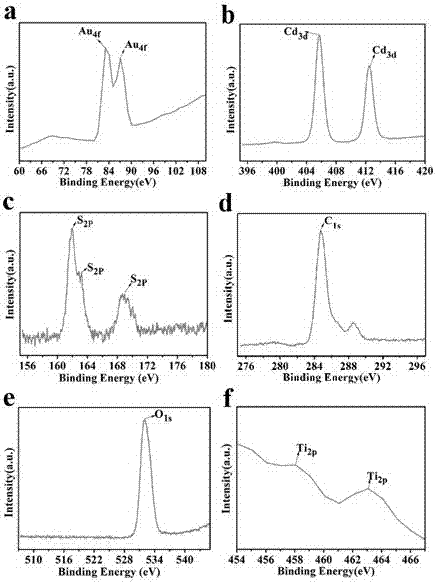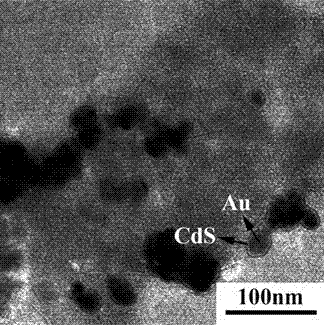Preparation method and application of a heterojunction photoelectrode
A heterojunction and photoelectrode technology, applied in the direction of material electrochemical variables, can solve problems such as limiting photoelectric conversion efficiency, and achieve the effects of cheap and easy-to-obtain materials, good repeatability, and good chemical stability
- Summary
- Abstract
- Description
- Claims
- Application Information
AI Technical Summary
Problems solved by technology
Method used
Image
Examples
Embodiment 1
[0035] A. TiO was prepared on FTO substrate 2 nanorod array
[0036] The described preparation of TiO on the FTO substrate 2 The steps of nanorod array are:
[0037] (1) Dissolve 15 mL of hydrochloric acid solution in 15 mL of deionized water, then slowly add 0.35 mL of butyl titanate to the solution and stir until the solution becomes clear to obtain mixed solution A.
[0038] (2) Transfer the mixed solution A to a reaction kettle lined with tetrafluoroethylene, put the cleaned FTO substrate in it, with the conductive side facing down, raise the temperature to 180 °C for 6 h, and cool naturally to obtain the surface Deposited with monolayer TiO 2 FTO substrate of nanorod arrays.
[0039] (3) Add 2 mL of acetic acid to 100 mL of ethanol, and then add 1.5 mL of butyl titanate and stir to form a uniform mixed solution B.
[0040] (4) Take out the above-mentioned FTO substrate, wash it with deionized water, and then soak it in solution B for 1 h.
[0041] (5) Put the soaked...
Embodiment 2
[0047] A. TiO was prepared on FTO substrate 2 Nanorod Arrays:
[0048] The described preparation of TiO on the FTO substrate 2 The steps of nanorod array are:
[0049] (1) Dissolve 15 mL of hydrochloric acid solution in 15 mL of deionized water, then slowly add 0.35 mL of butyl titanate to the solution and stir until the solution becomes clear to obtain mixed solution A.
[0050] (2) Transfer the mixed solution A to a reaction kettle lined with tetrafluoroethylene, put the cleaned FTO substrate in it, with the conductive side facing down, raise the temperature to 180 °C for 6 h, and cool naturally to obtain the surface Deposited with monolayer TiO 2 FTO substrate of nanorod arrays.
[0051] (3) Add 2 mL of acetic acid to 100 mL of ethanol, and then add 1.5 mL of butyl titanate and stir to form a uniform mixed solution B.
[0052] (4) Take out the above-mentioned FTO substrate, wash it with deionized water, and then soak it in solution B for 1 h.
[0053] (5) Put the soak...
Embodiment 3
[0059] A. TiO was prepared on FTO substrate 2 nanorod arrays.
[0060] The described preparation of TiO on the FTO substrate 2 The steps of nanorod array are:
[0061] (1) Dissolve 15 mL of hydrochloric acid solution in 15 mL of deionized water, then slowly add 0.35 mL of butyl titanate to the solution and stir until the solution becomes clear to obtain mixed solution A.
[0062] (2) Transfer the mixed solution A to a reaction kettle lined with tetrafluoroethylene, put the cleaned FTO substrate in it, with the conductive side facing down, raise the temperature to 180 °C for 6 h, and cool naturally to obtain the surface Deposited with monolayer TiO 2 FTO substrate of nanorod arrays.
[0063] (3) Add 2 mL of acetic acid to 100 mL of ethanol, and then add 1.5 mL of butyl titanate and stir to form a uniform mixed solution B.
[0064] (4) Take out the above-mentioned FTO substrate, wash it with deionized water, and then soak it in solution B for 1 h.
[0065] (5) Put the soak...
PUM
| Property | Measurement | Unit |
|---|---|---|
| diameter | aaaaa | aaaaa |
Abstract
Description
Claims
Application Information
 Login to View More
Login to View More - R&D
- Intellectual Property
- Life Sciences
- Materials
- Tech Scout
- Unparalleled Data Quality
- Higher Quality Content
- 60% Fewer Hallucinations
Browse by: Latest US Patents, China's latest patents, Technical Efficacy Thesaurus, Application Domain, Technology Topic, Popular Technical Reports.
© 2025 PatSnap. All rights reserved.Legal|Privacy policy|Modern Slavery Act Transparency Statement|Sitemap|About US| Contact US: help@patsnap.com



